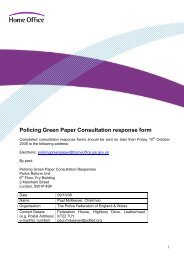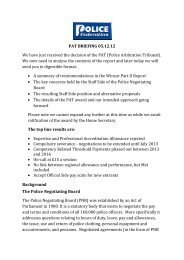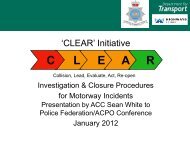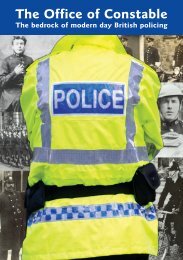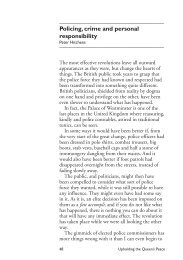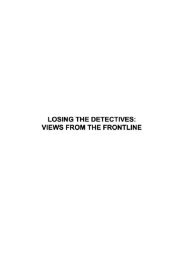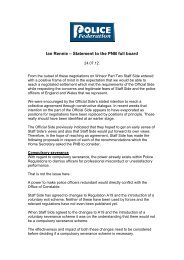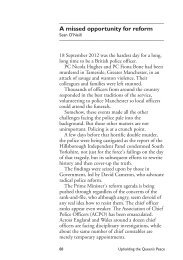Policing UK 2013 - Police Federation
Policing UK 2013 - Police Federation
Policing UK 2013 - Police Federation
Create successful ePaper yourself
Turn your PDF publications into a flip-book with our unique Google optimized e-Paper software.
OVERVIEW<br />
“Only if everyone – forces, PCCs, partners and<br />
the communities in each area – really appreciate<br />
the interplay between the various factors will<br />
the service be able to respond effectively.”<br />
The big problem with across the board<br />
percentage cuts in funding is it assumes<br />
that everyone is equally affected. This<br />
is not so. The proportion of each force’s<br />
budget which is met by grant ranges<br />
from about 51 per cent to over 0<br />
per cent.<br />
The forces at the upper end of the<br />
range have been worse affected in<br />
cash terms. Broadly speaking, those<br />
forces receive higher funding because<br />
their formula assessed needs relative to<br />
their local resources are proportionately<br />
higher.<br />
Moreover, an almost permanent<br />
feature of the annual grant settlements<br />
in recent years has been the application<br />
of flat rate increases for every authority.<br />
There are sound reasons for this – in a<br />
time of reducing grants it has protected<br />
individual authorities from being doubly<br />
affected by a reduction in the grant pool<br />
and a reduction in their local needs<br />
assessment.<br />
Clearly this strategy is more favourably<br />
received by the potential losers, and it<br />
is a fact that there are authorities now<br />
whose grant receipts are well over 20m<br />
a year lower than they would have been<br />
had damping not been applied. The<br />
range is now so great that it is doubtful<br />
if it can be bridged in the foreseeable<br />
future.<br />
The facts are that for the first time in<br />
recent memory, spending levels are going<br />
down, and the impact is not being felt<br />
equally across the country.<br />
Value for money<br />
Understanding the background is<br />
important. Only if everyone – forces,<br />
PCCs, partners and the communities<br />
in each area – really appreciate the<br />
interplay between the various factors will<br />
the service be able to respond effectively.<br />
<strong>Policing</strong> is a core public service, almost<br />
unique in having powers of arrest and<br />
prevention. It has come a long way from<br />
its origins as primarily a crime fighting<br />
service.<br />
Successive Home Secretaries have<br />
urged the service to refocus its efforts<br />
on crime, but at the same time they<br />
acknowledge and encourage the service’s<br />
contribution to the wider prevention,<br />
public protection and community safety<br />
role.<br />
As a nation, around 13bn a year is<br />
spent on policing. At a time of tightening<br />
resources, is there a realistic measure of<br />
whether this outlay provides value for<br />
money (VFM) The answer is probably<br />
‘no’. One of the difficulties is that VFM<br />
is often described purely in terms of cost<br />
reduction. This ignores the many other<br />
criteria by which effectiveness can be<br />
measured<br />
doing more for less<br />
doing the same but better<br />
customer satisfaction – making people<br />
feel safer<br />
meeting targets<br />
contributing ‘assists’ to other services.<br />
eal VFM in a time of reducing<br />
resources should not be measured simply<br />
in cash terms, but for convenience it<br />
often is.<br />
Discussions about the proper level<br />
of resources for policing are also often<br />
complicated – and at times distracted<br />
– by political or emotive issues. The<br />
ministerial focus on police officer<br />
numbers has only recently been relaxed,<br />
but in recent years it has meant that the<br />
debate has often been narrowed down<br />
to a single factor, when a wider more<br />
objective approach would have been<br />
more productive.<br />
Overtime levels have become an<br />
obsession, but as long as it is managed<br />
properly, it can be a very cost effective<br />
use of resources. Crime and detection<br />
rates are a critical measure, but the<br />
local or current context is often omitted.<br />
In its later years the efficiency regime<br />
eventually became a challenge to<br />
find ever more imaginative ways of<br />
recycling money within the budget, and<br />
it measured everything in cash terms<br />
when quality of service was an equally<br />
important factor.<br />
Bureaucracy and form filling has<br />
quite rightly been in the spotlight, but<br />
many of those who criticise the time<br />
spent on carefully recording incidents<br />
POLICING <strong>UK</strong> | 19



